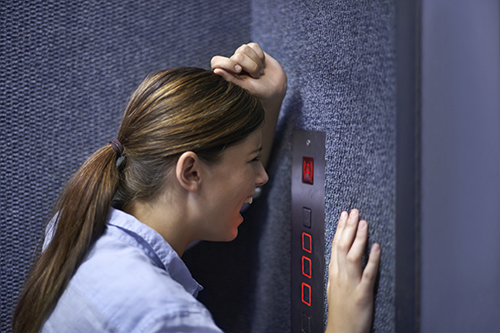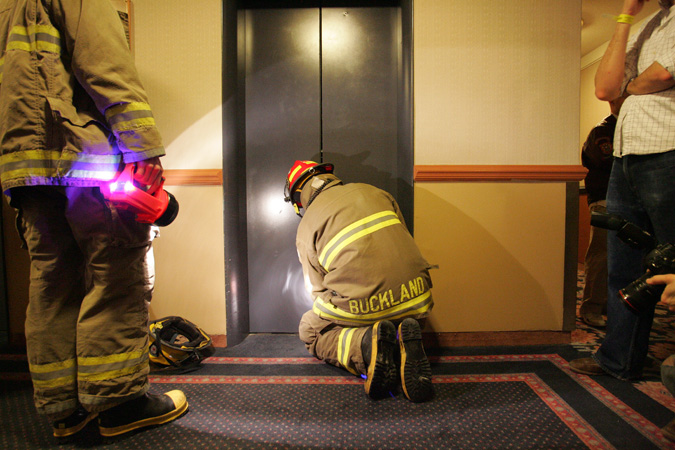Elevator emergencies can be a frightening experience for those in the elevator cab. Whether you’re dealing with medical emergencies or elevator malfunction, you want the occupants to feel safe.
Understanding what to do during an elevator emergency and how to prevent them not only gives you peace of mind, it can save you from an unfortunate incident.
While emergencies are not entirely avoidable, you can take steps to reduce the chances of an emergency.

Ensure Proper Maintenance and Repair of Your Elevators
The most common elevator emergencies are related to malfunction. To reduce these occurrences, you need to ensure proper maintenance. This includes:
- Making sure the elevator is free of dust and dirt
- Maintain a regular elevator maintenance schedule
- Always work with experienced repair technicians
Elevators and the machine room for the elevator must be free of dirt and dust. Regular cleaning will help prevent a buildup of debris, which could cause equipment malfunction.
Regular cleaning may be performed by your housekeeping crew. But, some areas can only be accessed by a qualified elevator repair technician.
Typically, if you’ve got an elevator, you’ve got a maintenance contract with a local elevator company. You should set up a schedule for regular maintenance, which may include monthly or bi-monthly visits.
During these regular maintenance visits, the technician will inspect the elevators and equipment. They will also look for uneven elevators. If the elevator is not level, it could be the result of worn out brakes.
Regular maintenance will help reduce the risk of elevator emergencies. But, human error can also lead to accidents.
Never Force an Elevator Door Open
One potential cause of user-related accidents is trying to force an elevator door open. If the elevator is stopped and the door won’t open, it should never be forced open.
The occupants should wait for security or an elevator technician to arrive. The door could close on the person or the elevator could resume moving. This could lead to severe injury or death.
Instead of attempting to force the door open, they should press the emergency call button. This emergency call button is a requirement in all passenger elevators.
Inform Your Staff of How to Deal with an Emergency
There should be someone on your premises that is aware of what to do in the event of an emergency. Typically, a communication system will be used to allow people in the elevator to place an emergency call.
If this call is directed to a concierge desk, they might need to assess the situation and determine if emergency personnel is required.
For example, in the event of a medical emergency, paramedics may be needed. But, during an elevator malfunction, a repair technician should be called.
Make sure that your staff knows what to do in these situations.
Also, inform your staff about the basics of elevator responsibility. This includes never rushing into an elevator as the doors close. This is a common cause of elevator-related accidents.
People assume that the door will stop closing if an object blocks the path of the door. The truth is that the door can continue to close, causing injury.
All elevators are required to have an emergency communication system. This system should be connected to an emergency power supply, in the event of power or equipment failure.
So, even if the elevator malfunctions or your building experiences a power outage, the occupants can still signal for help.
There are very specific requirements for the installation and placement of these communication systems.
Make Sure Occupants Never Use the Elevator During a Fire
In the event of a fire or other major emergency, people should never use the elevator. Instead, the emergency stairs should be used. The reason for this is that the fire could potentially cause a power outage or damage to equipment, which could result in elevator malfunction.
In the event of an elevator emergency, you don’t want people trapped in the elevator. To avoid this issue, make sure that emergency exits and stairs are clearly labeled.
Final Thoughts on Dealing with Elevator Emergencies
Reducing the risk of elevator emergencies requires proper maintenance. This means working with a company that can conduct regular visits.
In addition to maintenance, your staff or dedicated emergency monitoring company should be aware of proper procedures for dealing with elevator emergencies. This includes the use of emergency communication systems.
If you want to ensure that your employees or occupants are safe, you should take steps to reduce the risk of elevator emergencies. Keep these tips in mind.
These steps don’t require a major investment of time or money. They are simple, common-sense solutions for reducing the risk of emergencies. These steps can help you prepare so that you and your staff know what to do as emergencies arise.
Also, don’t forget to work with an experienced elevator repair company to maintain your elevators.




